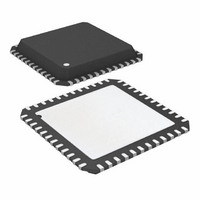AD7674ACPZRL Analog Devices Inc, AD7674ACPZRL Datasheet - Page 16

AD7674ACPZRL
Manufacturer Part Number
AD7674ACPZRL
Description
18-Bit,800kSPSSARADC
Manufacturer
Analog Devices Inc
Series
PulSAR®r
Datasheet
1.AD7674ASTZ.pdf
(28 pages)
Specifications of AD7674ACPZRL
Number Of Bits
18
Sampling Rate (per Second)
800k
Data Interface
Serial, Parallel
Number Of Converters
1
Power Dissipation (max)
138mW
Voltage Supply Source
Analog and Digital
Operating Temperature
-40°C ~ 85°C
Mounting Type
Surface Mount
Package / Case
48-VFQFN, CSP Exposed Pad
Lead Free Status / RoHS Status
Lead free / RoHS Compliant
For Use With
EVAL-AD7674CBZ - BOARD EVALUATION FOR AD7674
Lead Free Status / RoHS Status
Lead free / RoHS Compliant
AD7674
CIRCUIT INFORMATION
The AD7674 is a very fast, low power, single-supply, precise
18-bit analog-to-digital converter (ADC) using successive
approximation architecture.
The AD7674’s linearity and dynamic range are similar to or
better than many Σ-Δ ADCs. With the advantages of its
successive architecture, which ease multiplexing and reduce
power with throughput, it can be advantageous in applications
that normally use Σ-Δ ADCs.
The AD7674 features different modes to optimize performance
according to the applications. In Warp mode, the AD7674 is
capable of converting 800,000 samples per second (800 kSPS).
The AD7674 provides the user with an on-chip track/hold,
successive approximation ADC that does not exhibit any
pipeline or latency, making it ideal for multiple multiplexed
channel applications.
The AD7674 can be operated from a single 5 V supply and can
be interfaced to either 5 V or 3 V digital logic. It is housed in a
48-lead LQFP, or a tiny 48-lead LFCSP package that offers space
savings and allows for flexible configurations as either a serial
or parallel interface. The AD7674 is a pin-to-pin compatible
upgrade of the AD7676, AD7678, and AD7679.
CONVERTER OPERATION
The AD7674 is a successive approximation ADC based on a
charge redistribution DAC. Figure 25 shows the simplified
schematic of the ADC. The capacitive DAC consists of two
identical arrays of 18 binary weighted capacitors that are
connected to the two comparator inputs.
During the acquisition phase, terminals of the array tied to the
comparator’s input are connected to AGND via SW+ and SW–.
All independent switches are connected to the analog inputs.
Thus, the capacitor arrays are used as sampling capacitors and
acquire the analog signal on the IN+ and IN– inputs. When the
acquisition phase is complete and the CNVST input goes low, a
conversion phase is initiated. When the conversion phase
begins, SW+ and SW– are opened first. The two capacitor
REFGND
REF
IN–
IN+
262,144C 131,072C
262,144C 131,072C
MSB
MSB
Figure 25. ADC Simplified Schematic
Rev. A | Page 16 of 28
4C
4C
2C
2C
arrays are then disconnected from the inputs and connected to
the REFGND input. Therefore, the differential voltage between
the IN+ and IN– inputs captured at the end of the acquisition
phase is applied to the comparator inputs, causing the
comparator to become unbalanced. By switching each element
of the capacitor array between REFGND and REF, the
comparator input varies by binary weighted voltage steps
(V
switches, starting with the MSB first, to bring the comparator
back into a balanced condition. After completing this process,
the control logic generates the ADC output code and brings the
BUSY output low.
Modes of Operation
The AD7674 features three modes of operation: Warp, Normal,
and Impulse. Each mode is more suited for specific applications.
Warp mode allows conversion rates up to 800 kSPS. However,
in this mode and this mode only, the full specified accuracy is
guaranteed only when the time between conversions does not
exceed 1 ms. If the time between two consecutive conversions is
longer than 1 ms (e.g., after power-up), the first conversion
result should be ignored. This mode makes the AD7674 ideal
for applications where a fast sample rate is required.
Normal mode is the fastest mode (666 kSPS) without any
limitation on the time between conversions. This mode makes
the AD7674 ideal for asynchronous applications such as data
acquisition systems, where both high accuracy and fast sample
rate are required.
Impulse mode, the lowest power dissipation mode, allows
power saving between conversions. The maximum throughput
in this mode is 570 kSPS. When operating at 1 kSPS, for
example, it typically consumes only 136 μW. This feature makes
the AD7674 ideal for battery-powered applications.
REF
C
C
/2, V
REF
C
C
/4, ... V
LSB
LSB
SW+
SW–
REF
COMP
/262144). The control logic toggles these
SWITCHES
CONTROL
CONTROL
CNVST
LOGIC
OUTPUT
03083–0–025
CODE
BUSY













